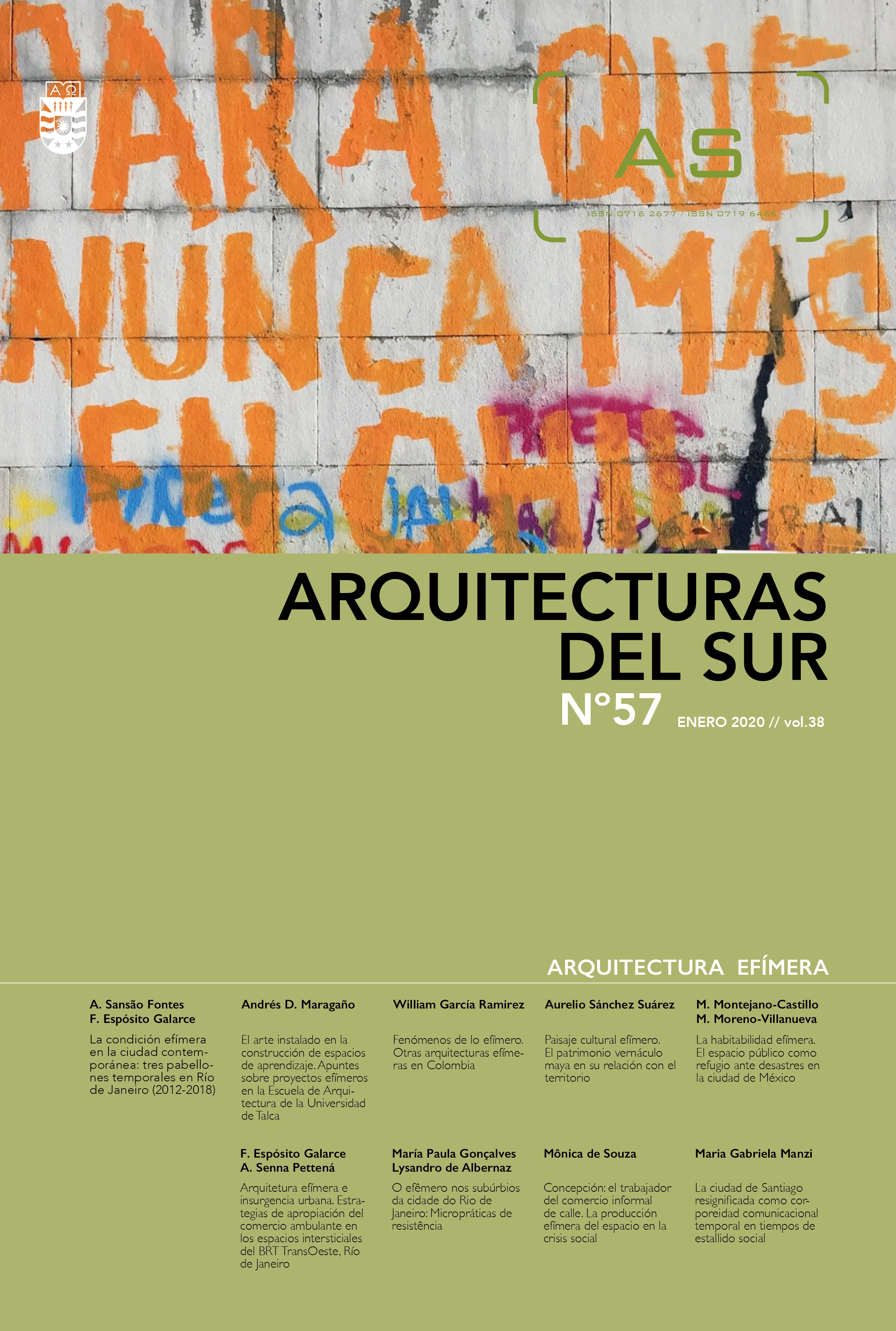The ephemeral condition in the contemporary city: three temporary pavilions in Rio de Janeiro
DOI:
https://doi.org/10.22320/07196466.2020.38.057.01Keywords:
Ephemeral architecture, contemporary architecture, pavilions, cities, Rio de JaneiroAbstract
In these first decades of the 21st century we live a specific moment of high modernity, characterized by transience in various spheres of social and economic relations, an ephemeral condition that expresses itself in the city and builds new spatial and architectural dynamics. This article seeks to reflect on the relationship between this ephemeral space-time condition and the contemporary society, observing how it materializes in the city. Specifically, we seek to understand how these characteristics are assimilated in architecture in the case of pavilions, one of the most ephemeral typologies in the field of architecture. To this end, we start from the discussion of some authors who deal with the paradigm shift from modernity to postmodernity, to then systematize and discuss the concepts of dynamism, reversibility, flexibility and unpredictability, with which the cases of the temporary pavilions will be evaluated. Finally, we conclude that these concepts offer a matrix with which it is possible to reread urban life, to operate on new ways of designing and conceiving the space of living and exchange in the city, thus responding to the ephemerality of the emotional, historical, physical and social.
Downloads
References
ASCHER, F. Mobilité e temps de la vie quotidienne. In: Les débats sur la ville 1. Bordeaux: Éditions Confluences. 1998.
AUGÉ, M. Não-Lugares. Introdução a uma antropologia da supermodernidade. Campinas: Papirus. 1994.
BAUMAN, Z. Modernidade líquida. Rio de Janeiro: Jorge Zahar. [(2000)2001].
CALVINO, I. Seis propostas para o próximo milênio. São Paulo: Companhia das Letras. 1990.
Da leveza: Para uma civilização do ligeiro. Lisboa, Portugal: Edições 70. 2016.
NIA, M. e MARTELLA, F. Reducing architecture: Doing almost nothing as a city-making strategy in 21st century architecture. Frontiers of Architectural Research, 2019, 8, PP. 154–163.
FERGUSON, F. Make_Shift City. Renegotiating the Urban Commons. Berlim: Jovis Verlag. 2014.
GAUSA, M. et al. Diccionario metápolis de arquitectura avanzada. Ciudad y tecnología en la sociedad de la información. Barcelona: Actar. 2001.
HARVEY, D. A condição pós-moderna. São Paulo: Loyola. [(1990)1993].
KOLAREVIC, B. Simplexity (and Complicity) in Architecture. In: Proceedings of the 34th eCAADe Conference, Oulu, Finland: Herneoja, Aulikki; Toni Österlund and Piia Markkanen (eds). University of Oulu, 2016, 1, pp. 25-31.
LABIT – Laboratório de Intervenções Temporárias e Urbanismo Tático. Disponível em: http://intervencoestemporarias.com.br/. Acesso em 16/11/2019.
LEHTOVUORI, P. e RUOPPILA, S. Temporary uses as means of experimental urban planning. SAJ - Serbian Architectural Journal, 2012, 4, pp. 29-53.
LIPOVETSKY, G. O império do efêmero. A moda e seu destino nas sociedades modernas. São Paulo: Cia das Letras. 1989.
PASSSARO, A. et al. Tornado Pavilion. Simplexity, almost nothing, but human expanded abilities. In: eCAADe 37 / SIGraDi 23 - Design - Collaboration and participation, 2019. 1, pp. 305-314.
PUENTE, M. Pabellones de exposición – 100 años. Barcelona: Editorial Gustavo Gili. 2000.
RIBEIRO, S. Do descartável ao efêmero: a redução do impacto ambiental no Design dos Espaços do Acontecimento. Dissertação de Mestrado em Design. Rio de Janeiro: Pontifícia Universidade Católica do Rio de Janeiro. 2019.
SANSÃO FONTES, A. Intervenções temporárias, marcas permanentes. Apropriações, arte e festa na cidade contemporânea. Rio de Janeiro: Casa da Palavra. 2013.
SANSÃO FONTES, A.; ESPÓSITO, F. e ARBUSÀ, S. Ar-quiteturas. Os infláveis como estratégia de reinterpretação do lugar. Revista Prumo, 2019, 7, pp. 138-151.
SANSÃO FONTES, A. e COURI FABIÃO, A. Além do público - privado: intervenções temporárias e criação de espaços coletivos no Rio de Janeiro. Revista de Arquitectura, 2016, 18(2), pp. 27-39.
SEGRE, R. Pavilhão Humanidade 2012. Uma arquitetura frágil e sustentável no evento Rio+20. Vitruvius Projetos, 2012, São Paulo, ano 12, n. pp. 138-139.02.
SENNETT, R. Carne e Pedra. Rio de Janeiro: Record. 1994.
SILVA, J. e ELOY, S. Arquitetura flexível: movimento e sistemas cinéticos. Arq.urb, 2012. 8, pp. 190-199.
TARDIVEAU, A. e MALLO, D. Unpacking and Challenging Habitus: An Approach to Temporary Urbanism as a Socially Engaged Practice. Journal of Urban Design, 2014. 19(4), pp. 456-472.
VALLANCE, S. et al. Temporary use and the onto-politics of ‘public’ space. Cities, 2017. 70, pp. 83-90.
Downloads
Published
How to Cite
Issue
Section
License
The content of the articles published in each issue of Arquitecturas del Sur is the sole responsibility of the authors and does not necessarily represent the opinion of University of the Bío-Bío.
The authors will maintain their copyright; however, they will guarantee the journal the right to first publication and dissemination of their work. The publication of the article in Arquitecturas del Sur will be subject to the Creative Commons International license (CC BY-SA) that allows others to adapt: remix, transform and build on the material for any purpose, even commercially; share: copy and redistribute the material in any medium or format, as long as the authorship and first publication in this journal are acknowledged by citing them correctly, and their new contributions are under a license with the same terms.














 Programa de Información Científica/Concurso Fondos de Publicación de Revistas Científicas 2018/ Proyecto Mejoramiento de Visibilidad de Revistas UBB (Código:FP180007)
Programa de Información Científica/Concurso Fondos de Publicación de Revistas Científicas 2018/ Proyecto Mejoramiento de Visibilidad de Revistas UBB (Código:FP180007) 
